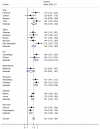Design and cohort description of the InterAct Project: an examination of the interaction of genetic and lifestyle factors on the incidence of type 2 diabetes in the EPIC Study
- PMID: 21717116
- PMCID: PMC4222062
- DOI: 10.1007/s00125-011-2182-9
Design and cohort description of the InterAct Project: an examination of the interaction of genetic and lifestyle factors on the incidence of type 2 diabetes in the EPIC Study
Abstract
Aims/hypothesis: Studying gene-lifestyle interaction may help to identify lifestyle factors that modify genetic susceptibility and uncover genetic loci exerting important subgroup effects. Adequately powered studies with prospective, unbiased, standardised assessment of key behavioural factors for gene-lifestyle studies are lacking. This case-cohort study aims to investigate how genetic and potentially modifiable lifestyle and behavioural factors, particularly diet and physical activity, interact in their influence on the risk of developing type 2 diabetes.
Methods: Incident cases of type 2 diabetes occurring in European Prospective Investigation into Cancer and Nutrition (EPIC) cohorts between 1991 and 2007 from eight of the ten EPIC countries were ascertained and verified. Prentice-weighted Cox regression and random-effects meta-analyses were used to investigate differences in diabetes incidence by age and sex.
Results: A total of 12,403 verified incident cases of type 2 diabetes occurred during 3.99 million person-years of follow-up of 340,234 EPIC participants eligible for InterAct. We defined a centre-stratified subcohort of 16,154 individuals for comparative analyses. Individuals with incident diabetes who were randomly selected into the subcohort (n = 778) were included as cases in the analyses. All prevalent diabetes cases were excluded from the study. InterAct cases were followed-up for an average of 6.9 years; 49.7% were men. Mean baseline age and age at diagnosis were 55.6 and 62.5 years, mean BMI and waist circumference values were 29.4 kg/m(2) and 102.7 cm in men, and 30.1 kg/m(2) and 92.8 cm in women, respectively. Risk of type 2 diabetes increased linearly with age, with an overall HR of 1.56 (95% CI 1.48-1.64) for a 10 year age difference, adjusted for sex. A male excess in the risk of incident diabetes was consistently observed across all countries, with a pooled HR of 1.51 (95% CI 1.39-1.64), adjusted for age.
Conclusions/interpretation: InterAct is a large, well-powered, prospective study that will inform our understanding of the interplay between genes and lifestyle factors on the risk of type 2 diabetes development.
Figures




References
-
- Sladek R, Rocheleau G, Rung J, Dina C, Shen L, Serre D, et al. A genome-wide association study identifies novel risk loci for type 2 diabetes. Nature. 2007 Feb 22;445(7130):881–5. - PubMed
-
- Saxena R, Voight BF, Lyssenko V, Burtt NP, de Bakker PI, Chen H, et al. Genome-wide association analysis identifies loci for type 2 diabetes and triglyceride levels. Science. 2007 Jun 1;316(5829):1331–6. - PubMed
-
- Steinthorsdottir V, Thorleifsson G, Reynisdottir I, Benediktsson R, Jonsdottir T, Walters GB, et al. A variant in CDKAL1 influences insulin response and risk of type 2 diabetes. Nat Genet. 2007 Jun;39(6):770–5. - PubMed
Publication types
MeSH terms
Grants and funding
- G0601261/CAPMC/ CIHR/Canada
- G1000143/MRC_/Medical Research Council/United Kingdom
- MC_U106179473/MRC_/Medical Research Council/United Kingdom
- MC_U106179471/MRC_/Medical Research Council/United Kingdom
- G0401527/MRC_/Medical Research Council/United Kingdom
- 083270/083270/z/WT_/Wellcome Trust/United Kingdom
- MC_UP_A090_1006/MRC_/Medical Research Council/United Kingdom
- G0601261/MRC_/Medical Research Council/United Kingdom
- CRUK_/Cancer Research UK/United Kingdom
- MC_EX_G0800783/MRC_/Medical Research Council/United Kingdom
- MC_UP_A100_1003/MRC_/Medical Research Council/United Kingdom
- 090532/WT_/Wellcome Trust/United Kingdom
- MC_U106179474/MRC_/Medical Research Council/United Kingdom
LinkOut - more resources
Full Text Sources
Medical

